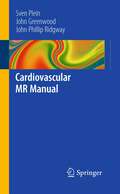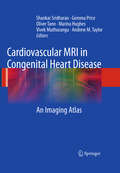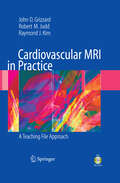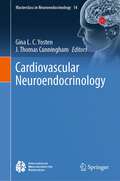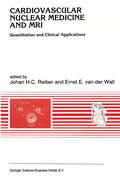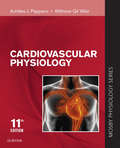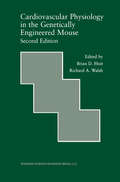- Table View
- List View
Cardiovascular MR Manual
by Sven Plein John Greenwood John P. RidgwayThe book provides an introduction to CMR imaging that is understandable and focused on the relevant information needed to using CMR imaging in clinical practice. Cardiovascular magnetic resonance (CMR) imaging has become an established imaging modality with an expanding range of clinical indications. While in the past the availability of CMR imaging was limited to a few specialist centres the method is becoming more widely available. Most clinicians therefore need to have a general understanding of the diagnostic information that can be obtained from CMR imaging, the indications for referral as well as contraindications and limitations of the method. For cardiologists and radiologists in particular, CMR imaging will become a routine diagnostic tool and training curricula in Cardiology or Radiology reflect this trend by increasingly demanding training in CMR imaging.
Cardiovascular MR Manual
by Sven Plein John Greenwood John P RidgwayThe aim of this book is to provide a compact text for practicing physicians and cardiologists or radiologists in training that contains all aspects of cardiovascular magnetic resonance imaging relevant for the appropriate use of this imaging modality in clinical practice. In a tutorial style, the book provides an overview of the relevant physics that govern CMR imaging and provide details on commonly accepted indications for referral. The book also provides the necessary background information to get trainees prepared for training in a CMR center. The emphasis of the book will be on practical, hands-on information in a format small enough to be carried about for ease of use. The book will be a dense but extremely portable reference for all cardiologists involved in using or requesting MRI of their cardiac patients. This will be an all-in-one resource and of great clinical value.
Cardiovascular MRI: 150 Multiple-Choice Questions and Answers (Contemporary Cardiology)
by Peter G. DaniasCardiac Magnetic Resonance (CMR) is a rapidly evolving imaging technology and is now increasingly utilized in patient care. Its advantages are noninvasiveness, superb image resolutions, and body tissue characterization. CMR is now an essential part of both cardiology and radiology training and has become part of the examination for Board certification. This book provides a condensed but comprehensive and reader friendly educational tool for cardiology fellows and radiology residents. It contains multiple choice questions similar to board examinations with concise comment and explanation about the correct answer.
Cardiovascular MRI in Congenital Heart Disease: An Imaging Atlas
by Shankar Sridharan Gemma Price Oliver Tann Marina Hughes Vivek Muthurangu Andrew M. TaylorThe last 10 years has seen explosive expansion of the number of centres performing cardiov- cular magnetic resonance (CMR) imaging. The majority of this expansion has been in the ? eld of adult ischaemic imaging, but congenital heart disease remains one of the main indications for CMR. Importantly, the greatly improved survival of patients with congenital heart disease gives us a burgeoning adult population living with the sequelae of the disease (grown-up c- genital heart disease – GUCH). Without previous experience or formal training, the interpretation of CMR images of patients with congenital heart disease can be dif? cult. The main aim of this book is to create a portable resource that offers ef? cient access to high-quality MR (and where appropriate, CT) images of the common congenital and structural heart abnormalities. We hope that by prov- ing key images for each condition and a clear interpretation of the MR appearances, we will improve the reader’s understanding of the conditions, facilitate their interpretation of images and optimise the planning of the imaging protocols during their own practice of congenital CMR. As with any publication from a single institution, the contents of this book represent our own practice. We have not written a de? nitive or exhaustive description of the conditions.
Cardiovascular MRI in Practice: A Teaching File Approach
by John Grizzard Robert Judd Raymond KimCardiovascular MR imaging has become a robust, clinically useful mod- ity, and the rapid pace of innovation and important information it conveys have attracted many students whose goal is to become adept practitioners. In turn, many excellent textbooks have been written to aid this process. These books are necessary and useful in helping the student learn the underlying pulse sequences used in CMR, as well as the imaging findings in a variety of disorders. However, one of the difficulties inherent in learning CMR from a book is that the printed format is not the ideal medium to d- play the dynamic imaging that comprises a typical CMR case. For instance, it may be difficult to perceive focal areas of wall motion abnormality on serial static pictures, but these abnormalities are often easily seen on cine loops. One might say that trying to learn CMR solely from a standard textbook with illustrations is like trying to learn to drive by looking at snapshots obtained through the windshield of a moving car. The learner needs to see the cardiac motion and decide if it is normal or abnormal; he or she needs to be in the driver’s seat. An additional limitation of the ava- able textbooks on CMR is that while they often have superb illustrations of abnormal findings, these images have been preselected.
Cardiovascular Neuroendocrinology (Masterclass in Neuroendocrinology #14)
by Gina L. C. Yosten J. Thomas CunninghamThe cardiovascular system and the neuroendocrine system are integrated at multiple levels. This integration is key to normal physiological function. Further, it adapts to accommodate changes related to aging, the organism’s reproductive state, or physiological challenges. This type of adaptability, or plasticity, also can contribute to pathophysiology when these systems are stressed. This volume discusses how neuroendocrine systems influence cardiovascular function in health and disease. The first section provides detailed background information on neuronal and neuroendocrine control of cardiovascular function. This is followed by chapters highlighting the cardiovascular role of neuroendocrine hormones in regulating physiological states, such as pregnancy, and the effects of biological sex on vascular function. The influence of exercise, stress, psychology, and aging on cardiovascular function and dysfunction, and the possibility of therapeutically targeting the neuroendocrine axis for the treatment of cardiovascular disease are discussed in the final section of the book.This book is of relevance for students, trainees and established researchers alike who are seeking for an overview on the neuroendocrine control of cardiovascular function and disease. This is the fourteenth volume in the International Neuroendocrine Federation (INF) Masterclass in Neuroendocrinology series, which aims to illustrate the highest standards and encourage the use of the latest technologies in basic and clinical research and hopes to provide inspiration for further exploration into the exciting field of neuroendocrinology.
Cardiovascular Nuclear Medicine and MRI: Quantitation and Clinical Applications (Developments in Cardiovascular Medicine #128)
by Johan H. C. Reiber Ernst E. Van Der WallIn recent years there have been major advances in the fields of cardiovascular nuclear medicine and cardiac magnetic resonance imaging. In nuclear cardiology more adequate tomographic systems have been designed for routine cardiac use, as well as new or improved quantitative analytic software packages both for planar and tomographic studies implemented on modern state-of-the-art workstations. In addition, artificial intelligence techniques are being applied to these images in attempts to interpret the nuclear studies in a more objective and reproducible manner. Various new radiotracers have been developed, such as antimyosin, labeled isonitriles, metabolic compounds, etc. Furthermore, alternative stress testing with dipyridamole and dobutamine has received much attention in clinical cardiac practice. Magnetic resonance imaging is a relative newcomer in cardiology and has already shown its merits, not only for anatomical information but increasingly for the functional aspects of cardiac performance. This book covers almost every aspect of quantitative cardiovascular nuclear medicine and magnetic resonance imaging. It will assist the nuclear medicine physician, the radiologist, the physicist/image processing specialist and the clinical cardiologist in understanding the nuclear medicine techniques used in cardiovascular medicine, and in increasing our knowledge of cardiac magnetic resonance imaging.
Cardiovascular OCT Imaging
by Ik-Kyung JangOCT is rapidly being adopted in cardiology practice. However, gap exists between the speed of technology development and the knowledge of cardiologists. Many cardiologists are not familiar with image interpretation and don’t have enough background/knowledge to use the information in clinical practice. This book will be designed for busy interventional cardiologists to become quickly familiar with this emerging technology so that they can take advantage of its power improve patient care and outcome.
Cardiovascular OCT Imaging
by Ik-Kyung JangThis heavily revised second edition comprehensively reviews the use of optical coherence tomography (OCT) in cardiovascular practice. It provides detailed guidance on how to properly interpret OCT images and successfully utilise it in daily clinical practice Chapters cover the development and physics associated with OCT, relevant interpretation skills, OCT imaging artifacts, plaque erosion, bioabsorbable stent, the detection of vulnerable plaque, and the use of OCT imaging in unison with other modalities such as phase contrast imaging (PCI). Areas of potential future development are also covered Cardiovascular OCT Imaging enables interventional cardiologists and cardiologists to quickly become both familiar and develop a detailed understanding of this technology to improve patient care and treatment outcome. It is a valuable reference for all practising and trainee medical professionals in cardiology, and in particular those who specialize in interventional cardiology.
Cardiovascular Outcomes Research: A Clinician’s Guide to Cardiovascular Epidemiology and Clinical Outcomes Trials (Contemporary Cardiology)
by Kevin C. Maki Don P. WilsonThis book provides clinicians with the information needed to effectively interpret the literature from observational and interventional cardiovascular outcomes studies. The book begins by providing a historical context of cardiovascular epidemiology, followed by chapters addressing key concepts in the study of cardiovascular disease such as the types of cardiovascular outcomes studies, basic and evolving design and statistical considerations, current guidelines for reducing atherosclerotic cardiovascular disease risk, surrogate markers of cardiovascular disease, challenges in developing evidence-based recommendations for non-pharmacological interventions, an overview of the pharmaceutical development process, and a detailed discussion of the clinical evidence supporting several factors and their relationships with atherosclerotic cardiovascular disease (lipids, inflammation, hemostasis, heart rhythm, blood pressure, diabetes, obesity, and chronic kidney disease). Cardiovascular Outcomes Research is a must-have resource for physicians and other clinicians, residents, fellows, and medical students in cardiology, endocrinology, primary care, and health promotion and disease prevention.
Cardiovascular Pediatric Critical Illness and Injury
by Derek S. Wheeler Hector R. Wong Thomas P. ShanleyThe development of pediatric cardiac surgical programs has had a profound effect on the s- cialty of pediatric critical care medicine, and as a result, the ? eld of pediatric cardiac intensive care is rapidly emerging as a separate subspecialty of pediatric critical care medicine. The ability to provide care for the critically ill child with congenital heart disease clearly separates pediatric intensivists from our adult colleagues. A thorough understanding and knowledge of the unique physiology of the child with congenital heart disease are therefore absolutely crucial for anyone working in the pediatric intensive care unit. Once again, we would like to dedicate this textbook to our families and to the physicians and nurses who provide steadfast care every day in pe- atric intensive care units across the globe. Derek S. Wheeler Hector R. Wong Thomas P. Shanley v Preface to Pediatric Critical Care Medicine: Basic Science and Clinical Evidence The ? eld of critical care medicine is growing at a tremendous pace, and tremendous advances in the understanding of critical illness have been realized in the last decade. My family has directly bene? ted from some of the technological and scienti? c advances made in the care of critically ill children. My son Ryan was born during my third year of medical school. By some peculiar happenstance, I was nearing completion of a 4-week rotation in the newborn intensive care unit (NICU).
Cardiovascular Pharmacogenetics (Handbook of Experimental Pharmacology #160)
by Martin R. WilkinsThe Human Genome Project was sold to the general public largely on the basis that a complete picture of the structure of human DNA would lead to new and better medicines. These medicines would be better because they would be tailored to individual patients, maximising the chances of a therapeutic response and mi nimising the risks of an adverse event. Taking the idea further, pundits have pre dicted that the time will come when we could carry our DNA on a card which could be read rapidly and enable the physician to choose the best drug. This is the future. This is pharmacogenetics. When the draft human DNA sequence was announced and scientists were as ked how this would help drug development, the example most frequently given was the debrisoquine model - where poor metabolisers of this hypotensive agent are exposed to higher plasma levels from a standard dose and at risk of collapse from excessive hypotension. This observation was made over 20 years ago and predated designs to sequence the human genome. Nonetheless, it raised aware ness of variation in drug metabolism and was correctly assigned to genetic poly morphisms affecting CYP2D6. Together with the discovery of pseudocholinestera se deficiency, it marked the birth of pharmacogenetics. The debrisoquine example is an interesting one and worthy of further analysis.
Cardiovascular Pharmacology of 5-Hydroxytryptamine: Prospective Therapeutic Applications (Developments in Cardiovascular Medicine #106)
by P. R. Saxena D. I. Wallis W. Wouters P. BevanCardiovascular Physiology: A Text and E-Resource for Active Learning
by Burt B. HamrellCardiovascular disease remains the chief cause of mortality and morbidity in adults in many parts of the world, and diagnosis and treatment is increasingly based on cellular, intracellular, and molecular parameters as well as systems analysis. Consequently, it is vital that medical students learn the fundamental physiology of the cardiovascular system. This book, along with its interactive electronic learning modules, breathes life into the subject, with animations, videos, and game-like decision-making.
Cardiovascular Physiology: A Text and E-Resource for Active Learning
by Burt B. HamrellCardiovascular disease remains the chief cause of mortality and morbidity in adults in many parts of the world, and diagnosis and treatment is increasingly based on cellular, intracellular, and molecular parameters as well as systems analysis. Consequently, it is vital that medical students learn the fundamental physiology of the cardiovascular system. This book, along with its interactive electronic learning modules, breathes life into the subject, with animations, videos, and game-like decision-making.
Cardiovascular Physiology E-Book: Mosby Physiology Monograph Series (Mosby's Physiology Monograph)
by Achilles J. Pappano Withrow Gil WierCardiovascular Physiology gives you a solid understanding of how the cardiovascular system functions in both health and disease. Ideal for your systems-based curriculum, this title in the Mosby Physiology Monograph Series explains how the latest concepts apply to real-life clinical situations. Consult this title on your favorite e-reader, conduct rapid searches, and adjust font sizes for optimal readability. Get clear, accurate, and up-to-the-minute coverage of the physiology of the cardiovascular system. Master the material easily with objectives at the start of each chapter; self-study questions, summaries, and key words and concepts. Grasp the latest concepts in vascular, molecular, and cellular biology as they apply to cardiovascular function, thanks to molecular commentaries in each chapter.Apply information to clinical situations with the aid of clinical commentaries and highlighted clinical vignettes throughout.
Cardiovascular Physiology - E-Book: Mosby Physiology Monograph Series (with Student Consult Online Access) (Mosby's Physiology Monograph)
by Achilles J. Pappano Withrow Gil WierGain a foundational understanding of cardiovascular physiology and how the cardiovascular system functions in health and disease. Cardiovascular Physiology, a volume in the Mosby Physiology Series, explains the fundamentals of this complex subject in a clear and concise manner, while helping you bridge the gap between normal function and disease with pathophysiology content throughout the book.Helps you easily master the material in a systems-based curriculum with learning objectives, Clinical Concept boxes, highlighted key words and concepts, chapter summaries, self-study questions, and a comprehensive exam to help prepare for USMLEs.Keeps you current with the latest concepts in vascular, molecular, and cellular biology as they apply to cardiovascular function, thanks to molecular commentaries in each chapter.Includes clear, 2-color diagrams that simplify complex concepts.Features clinical commentaries that show you how to apply what you've learned to real-life clinical situations. Complete the Mosby Physiology Series! Systems-based and portable, these titles are ideal for integrated programs. Blaustein, Kao, & Matteson: Cellular Physiology and NeurophysiologyCloutier: Respiratory PhysiologyKoeppen & Stanton: Renal PhysiologyJohnson: Gastrointestinal PhysiologyWhite, Harrison, & Mehlmann: Endocrine and Reproductive PhysiologyHudnall: Hematology: A Pathophysiologic Approach
Cardiovascular Physiology in Exercise and Sport E-Book
by Christopher BellThis title is directed primarily towards health care professionals outside of the United States. Written by an eminent cardiovascular physiologist with a strong track record in dealing with issues related to exercise and environmental physiology, this text covers cardiovascular function from the exercise and human physiologist's viewpoint. It provides a solid foundation of knowledge of how the cardiovascular system responds and adapts to the challenges of exercise and environmental change, and analyses the practicalities of measuring cardiovascular parameters in normal human subjects.Case studies in exercise physiology throughout text.Open-ended questions at end of each chapter encourage students to explore common situations facing exercise and human physiologists.Bibliography at end of each chapter directs students to further reading resources.Summaries at start of each chapter and multiple choice questions with explanatory answers at end of book aid revision and help students test their knowledge.
Cardiovascular Physiology in the Genetically Engineered Mouse (Developments in Cardiovascular Medicine #238)
by William H. Isbell Helaine SilvermanThe enormous advances in molecular biology and genetics coupled with the progress in instrumentation and surgical techniques have produced a voluminous and often bewildering quantity of data. The need for a second edition of Cardiovascular Physiology in the Genetically Engineered Mouse is underscored not only by these rapid advances, but by the increasing numbers of scientists who have focussed their research on genetically engineered mice. It is the primary objective of this second edition to interpret critically the literature and to provide a framework for the enormous amount of information in this burgeoning field. As in the first edition, the monograph serves as a practical guide for the investigator interested in the functional methods used to characterize the murine cardiovascular phenotype. However, this guidebook is a more comprehensive text than its predecessor; although the major objectives enumerated in the first edition have not substantially changed, they have been refined in keeping with the increased sophistication of the molecular biologist, geneticist, and physiologist in each other's discipline. Each chapter has been expanded and updated, richly enhanced with original tables and figures, and in many cases, extensively rewritten. Eight chapters written by internationally recognized experts have been added; this represents a 43 % increase from the first edition.
Cardiovascular Physiology: Questions for Self Assessment
by Rodney J LevickAn Introduction to Cardiovascular Physiology provides the student with the key concepts of cardiovascular physiology, from the fundamentals of how the cardiovascular system works in both health and disease, through to a consideration of more complex physiological mechanisms. This brand new companion work Cardiovascular Physiology: Questions for Sel
Cardiovascular Plaque Rupture
by David L. BrownIllustrating the development and determinants of possible plaque rupture, Cardiovascular Plaque Rupture provides an in-depth review of the pathology, etiology, cellular and molecular biology, diagnosis, and treatment of plaque in the cardiovascular system-exploring the roles of physical stress, inflammation, and infectious agents on the growth of c
Cardiovascular Prevention and Rehabilitation
by Peter Mathes Helmut Gohlke Catherine Monpère Irene Hellemans Hannah McGee Philippe Sellier Hugo Saner Joep PerkThis book is a timely and thorough review of prevention, lifestyle counseling and rehabilitation for cardiologists and all physicians and other health professionals in cardiac rehabilitation teams. The Editors have gathered over 60 experts from all parts of the globe. Each highlights the role of cardiac rehabilitation and preventative cardiology from exercise testing and training, through nutrition, smoking cessation, behavioral and social support to adapted programs for newer groups with specific demands. The book emphasizes the organizational aspects of cardiac rehabilitation, including quality assurance and economic evaluation.
Cardiovascular Prevention and Rehabilitation in Practice
by Jennifer Jones John Buckley Gill Furze Gail SheppardThe authoritative clinical handbook promoting excellence and best practice Cardiovascular Prevention and Rehabilitation in Practice is a comprehensive, practitioner-focused clinical handbook which provides internationally applicable evidence-based standards of good practice. Edited and written by a multidisciplinary team of experts from the British Association for Cardiovascular Prevention and Rehabilitation (BACPR), this book is invaluable for practitioners helping people with heart disease return to health. The text provides an overview of research findings, examines the core components of cardiac rehabilitation, and discusses how to support healthier lifestyles and reduce the risks of recurrence. Now in its second edition, this textbook has been fully revised to incorporate recent clinical evidence and align with current national and international guidelines. Increased emphasis is placed on an integrated approach to cardiac rehabilitation programmes, whilst six specified standards and six core components are presented to promote sustainable health outcomes. Describes how cardiovascular prevention and rehabilitation programmes can be delivered to meet standards of good practice Covers a broad range of topics including: promoting health behaviour change to improve lifestyle risk factors, supporting psycho-social health, managing medical risk factors, and how to develop long-term health strategies Emphasises the importance of early programme commencement with assessment and reassessment of patient goals and outcomes, and gives examples of strategies to achieve these Discusses the role of programme audit and certification of meeting minimum standards of practice Looks to the future and how delivery of cardiovascular prevention and rehabilitation programmes internationally will need to meet common challenges Cardiovascular Prevention and Rehabilitation in Practice is an indispensable resource for all health professionals involved in cardiac rehabilitation and cardiovascular disease prevention.
Cardiovascular Prevention and Rehabilitation in Practice
by Jennifer Jones John Buckley Gill Furze Gail SheppardThe authoritative clinical handbook promoting excellence and best practice Cardiovascular Prevention and Rehabilitation in Practice is a comprehensive, practitioner-focused clinical handbook which provides internationally applicable evidence-based standards of good practice. Edited and written by a multidisciplinary team of experts from the British Association for Cardiovascular Prevention and Rehabilitation (BACPR), this book is invaluable for practitioners helping people with heart disease return to health. The text provides an overview of research findings, examines the core components of cardiac rehabilitation, and discusses how to support healthier lifestyles and reduce the risks of recurrence. Now in its second edition, this textbook has been fully revised to incorporate recent clinical evidence and align with current national and international guidelines. Increased emphasis is placed on an integrated approach to cardiac rehabilitation programmes, whilst six specified standards and six core components are presented to promote sustainable health outcomes. Describes how cardiovascular prevention and rehabilitation programmes can be delivered to meet standards of good practice Covers a broad range of topics including: promoting health behaviour change to improve lifestyle risk factors, supporting psycho-social health, managing medical risk factors, and how to develop long-term health strategies Emphasises the importance of early programme commencement with assessment and reassessment of patient goals and outcomes, and gives examples of strategies to achieve these Discusses the role of programme audit and certification of meeting minimum standards of practice Looks to the future and how delivery of cardiovascular prevention and rehabilitation programmes internationally will need to meet common challenges Cardiovascular Prevention and Rehabilitation in Practice is an indispensable resource for all health professionals involved in cardiac rehabilitation and cardiovascular disease prevention.
Cardiovascular Problems in Emergency Medicine: A Discussion-based Review (Current Topics in Emergency Medicine #3)
by Shamai A. Grossman Peter RosenA unique textbook in cardiovascular emergencies Cardiovascular Problems in Emergency Medicine takes you on rounds with the leading teachers of emergency medicine. Transcripts of in-depth telephone conferences on 27 real-life cardiovascular cases provide a unique and fascinating insight into the way complex cases are diagnosed and managed by some of the most experienced and respected practitioners in the field. Each chapter is then complemented by an authoritative, fully-referenced review of the current literature on the topic. With its unique approach, and the range of cases covered, Cardiovascular Problems in Emergency Medicine is an invaluable source of information for all emergency physicians, both qualified and in training.

